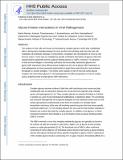| dc.contributor.author | Raman, Rahul | |
| dc.contributor.author | Tharakaraman, Kannan | |
| dc.contributor.author | Sasisekharan, Viswanathan | |
| dc.contributor.author | Sasisekharan, Ram | |
| dc.date.accessioned | 2018-09-11T15:09:17Z | |
| dc.date.available | 2018-09-11T15:09:17Z | |
| dc.date.issued | 2016-10 | |
| dc.identifier.issn | 0959-440X | |
| dc.identifier.uri | http://hdl.handle.net/1721.1/117708 | |
| dc.description.abstract | The surfaces of host cells and viruses are decorated by complex glycans, which play multifaceted roles in the dynamic interplay between the virus and the host including viral entry into host cell, modulation of proteolytic cleavage of viral proteins, recognition and neutralization of virus by host immune system. These roles are mediated by specific multivalent interactions of glycans with their cognate proteins (generally termed as glycan-binding proteins or GBPs or lectins). The advances in tools and technologies to chemically synthesize and structurally characterize glycans and glycan–GBP interactions have offered several insights into the role of glycan–GBP interactions in viral pathogenesis and have presented opportunities to target these interactions for novel antiviral therapeutic or vaccine strategies. This review covers aspects of role of host cell surface glycan receptors and viral surface glycans in viral pathogenesis and offers perspectives on how to employ various analytical tools to target glycan–GBP interactions. | en_US |
| dc.description.sponsorship | National Institutes of Health (U.S.) (Grant R37 GM057073-13) | en_US |
| dc.publisher | Elsevier | en_US |
| dc.relation.isversionof | http://dx.doi.org/10.1016/J.SBI.2016.10.003 | en_US |
| dc.rights | Creative Commons Attribution-NonCommercial-NoDerivs License | en_US |
| dc.rights.uri | http://creativecommons.org/licenses/by-nc-nd/4.0/ | en_US |
| dc.source | PMC | en_US |
| dc.title | Glycan–protein interactions in viral pathogenesis | en_US |
| dc.type | Article | en_US |
| dc.identifier.citation | Raman, Rahul et al. “Glycan–protein Interactions in Viral Pathogenesis.” Current Opinion in Structural Biology 40 (October 2016): 153–162 © 2016 The Authors | en_US |
| dc.contributor.department | Massachusetts Institute of Technology. Department of Biological Engineering | en_US |
| dc.contributor.department | Koch Institute for Integrative Cancer Research at MIT | en_US |
| dc.contributor.mitauthor | Raman, Rahul | |
| dc.contributor.mitauthor | Tharakaraman, Kannan | |
| dc.contributor.mitauthor | Sasisekharan, Viswanathan | |
| dc.contributor.mitauthor | Sasisekharan, Ram | |
| dc.relation.journal | Current Opinion in Structural Biology | en_US |
| dc.eprint.version | Author's final manuscript | en_US |
| dc.type.uri | http://purl.org/eprint/type/JournalArticle | en_US |
| eprint.status | http://purl.org/eprint/status/PeerReviewed | en_US |
| dc.date.updated | 2018-09-10T19:06:35Z | |
| dspace.orderedauthors | Raman, Rahul; Tharakaraman, Kannan; Sasisekharan, V; Sasisekharan, Ram | en_US |
| dspace.embargo.terms | N | en_US |
| dc.identifier.orcid | https://orcid.org/0000-0002-2085-7840 | |
| mit.license | PUBLISHER_CC | en_US |
